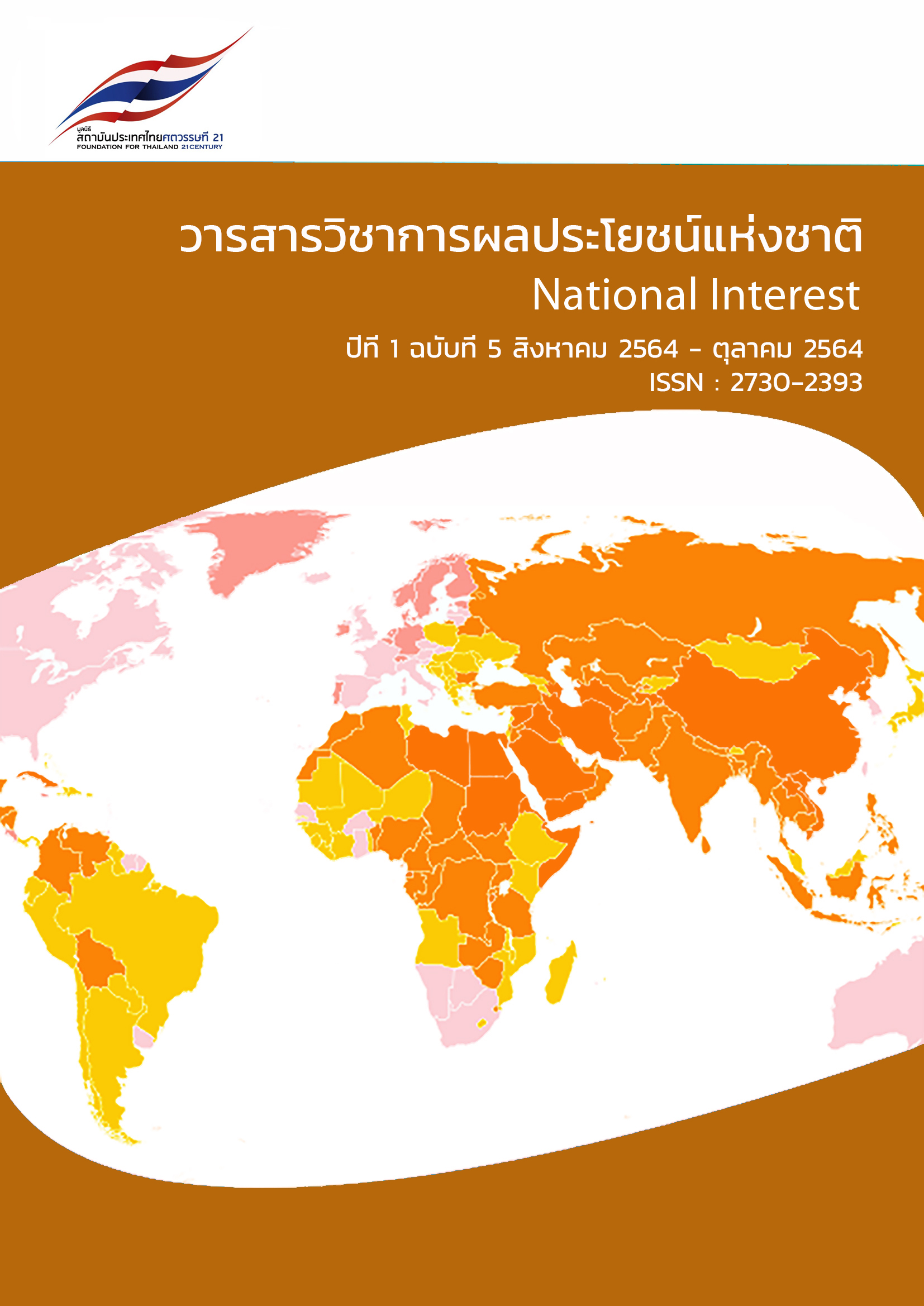Evolving Political Ideas and Organizational Practices of Ukraine’s ‘Activist’ Organizations, 2013-2019
Main Article Content
บทคัดย่อ
The events of Euromaidan and the subsequent processes of political development under the conditions of the undeclared Russian-Ukrainian war and the related political crisis were accompanied by the significant development of informal and semi-formal political groups and organizations, collectively known as “activists". Nevertheless, despite the empirically proven and intensive participation of these groups in both street and formal politics of Ukraine, it seems that the ideological and political nature of these organizations and the depth of their involvement in political processes in modern Ukrainian society and politics remain unclear. That is why this article aims to clarify these two aspects of a particular issue, based on the need for theoretical and empirical research of "activists" as not only a mediatic but also a political entity. The article traces the structure of relations of activist groups (organizations) singled out as a subject of research with other formal and informal political actors (public authorities, political parties, law enforcement agencies, churches and religious organizations, etc.) is traced. The study took a step toward determining the ideological and political specifics of the "activist" field of informal political life of Ukrainian society in the years from Euromaidan to the election of President of Ukraine V. Zelensky and described the extent and degree of integration of "activist" groups in Ukraine's political system in the circumstance of a social crisis.
Article Details

อนุญาตภายใต้เงื่อนไข Creative Commons Attribution-NonCommercial-NoDerivatives 4.0 International License.
วารสารวิชาการผลประโยชน์แห่งชาติ ภายใต้ Creative Commons Attribution-NonCommercial-NoDerivatives 4.0 International License วารสารอนุญาตให้มีการเข้าถึงหรือเผยแพร่งานทางวิชาการได้โดยไม่มีค่าใช้จ่ายหรือมีการลงทะเบียน เพื่อเป็นการสนับสนุนการแลกเปลี่ยนความรู้ ขอบข่ายครอบคลุมงานวิชาการด้านภูมิรัฐศาสตร์ ภูมิเศรษฐศาสตร์ และนวัตกรรมผู้ใช้สามารถแบ่งปัน คัดลอก และกระจายข้อมูลทั้งหมดที่ตีพิมพ์ใน วารสารวิชาการผลประโยชน์แห่งชาติ ในรูปแบบหรือสื่อใดก็ตามตามเงื่อนไขต่อไปนี้:
การอ้างอิง — อนุญาตให้นำผลงานไปใช้ ทำซ้ำ แจกจ่าย หรือดัดแปลงงานนั้นได้ แต่ต้องให้เครดิตที่มาของเจ้าของผลงานนั้น ซึ่งถ้ามีการใช้ผลงานนั้นโดยไม่มีเครดิตชื่อเจ้าของผลงานกำกับ จะต้องทำการขอนุญาตเจ้าของผลงานก่อน
ไม่ใช้เพื่อการค้า — อนุญาตให้นำผลงานไปใช้ ทำซ้ำ แจกจ่าย หรือดัดแปลงงานนั้นได้ แต่ไม่สามารถใช้ผลงานหรือบทความเพื่อวัตถุประสงค์ทางการค้าได้
ไม่สามารถดัดแปลง — อนุญาตให้นำผลงานไปใช้ ทำซ้ำ แจกจ่าย ผลงานชิ้นนั้นได้ แต่ห้ามดัดแปลงงาน เว้นแต่ว่าจะได้รับการอนุญาตจากเจ้าของผลงานก่อน
เอกสารอ้างอิง
H. McClosky, “Consensus and ideology in American politics,”American Political Science Review,
vol. 58, pp. 361-382,1964
J. Nagel, Participation. Harlow: Prentice Hall, 1987.
T. Böhm, “Activists in politics: the influence of embedded activists on the success of social
movements,”Social Problems, vol. 62, no.4, pp. 477-498 , November 2015
M. Diani, “The concept of social movement,”The Sociological Review,vol. 40, no.1, pp.
-25,1992,
F. Polletta and J. M. Jasper, “Collective identity and social movements,” Annual Review of Sociology,
vol. 27, pp. 283-305,2001
D. Angi, “Beyond the boundaries of nation-state: images of global civil society,”Polish Sociological
Review, no.149, pp. 15-29, 2005
M. Diani and D. McAdam, eds., Social Movements and Networks: Relational Approaches to Collective
Action. Oxford: Oxford University Press, 2003
A. A. Reda, S. Sinanoglu and M. Abdalla, “Mobilizing the masses: measuring resource mobilization on Twitter,” Sociological Methods & Research, August 2021. [Online]. Available:
https://doi.org/10.1177%2F0049124120986197 [Accessed September 2, 2021].
Y. Sintomer, “The meanings of political representation: uses and misuses of a notion,”Raisons Politiques, vol. 50, no. 2, pp. 13-34, 2013
J. Sánchez-Villar, E. Bigné and J. Aldás-Manzano, “Blog influence and political activism: an
emerging and integrative model,” Spanish Journal of Marketing – ESIC,vol. 21, no.2, pp. 102-
,September2017
D. R. Fisher, “Youth political participation: bridging activism and electoral politics,” Annual Review
of Sociology,vol. 38, pp. 119-137 , 2012
O. Nikolayenko, “The revolt of the post-Soviet generation: youth movements in Serbia, Georgia,
and Ukraine,” Comparative Politics, vol. 39, no.2, pp.169-188, January 2007,
O. Onuch, Mapping Mass Mobilizations: Understanding Revolutionary Movements in Argentina and Ukraine. Basingstoke: Palgrave Macmillan, 2014
C. Tilly, The Contentious French. Cambridge, MA: Harvard University Press, 1986.
S. Tarrow, Power in Movement: Social Movements and Contentious Politics, 2nd ed. Cambridge:
Cambridge University Press, 1998
J. D. McCarthy and M. N. Zald, “Resource mobilization and social movements: a partial theory,” American Journal of Sociology,vol. 82, no.6, pp.1212-1241 , May 1977
M. N. Zald, “Epilogue: social movements and political sociology in the analysis of organizations and
markets,”Administrative Science Quarterly, vol. 53, no. 3, pp. 568-574, September 2008
S. Crasnow, “The role of case study research in political science: evidence for causal claims,”
Philosophy of Science, vol. 79, no.5, pp. 656-666, 2012
Y. Shveda and J. H. Park, “Ukraine's revolution of dignity: the dynamics of Euromaidan,”Journal of Eurasian Studies, vol. 7, no.1, pp. 85-91 , January 2016
V. Ishchenko, “Far right participation in the Ukrainian Maidan protests: an attempt of systematic
estimation,” European Politics and Society, vol. 17, no.4, pp. 453-472, March 2016
E. Kuhn von Burgsdorff, “The Euromaidan Revolution in Ukraine: stages of the Maidan movement and why they constitute a revolution,”Inquiries, vol. 7, no.2, pp. 1-3,2015
N. N. Petro, ed., Ukraine in Crisis. London and New York: Routledge, 2017.
V. Likhachev, “The “Right Sector” and others: the behavior and role of radical nationalists in the Ukrainian political crisis of late 2013 – early 2014,”Communist and Post-Communist Studies, vol. 48,no. 2/3, pp. 257-271. June / September 2015
I. Gomza and J. Zajaczkowski, “Black sun rising: political opportunity structure perceptions and
institutionalization of the Azov Movement in post-Euromaidan Ukraine,”Nationalities Papers, vol.
, no.5, pp. 774–800, 2019
Y. Yakymenko, ed., Ukraine’s Party System Evolution: 1990-2017. Kyiv: Razumkov Centre,
A. Karatnycky, “The rise and fall of Mikheil Saakashvili,”Politico, February 12, 2018. [Online].
Available: https://www.politico.eu/article/the-rise-and-fall-of-mikheil-saakashvili/ [Accessed
September 2, 2021].


